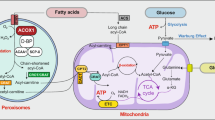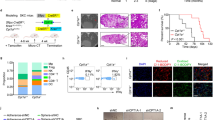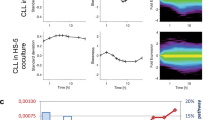Abstract
Targeting the mechanisms that allow chronic lymphocytic leukemia (CLL) cells to survive in harsh cancer microenvironments should improve patient outcomes. The nuclear receptor peroxisome proliferator activated receptor delta (PPARδ) sustains other cancers, and in silico analysis showed higher PPARD expression in CLL cells than normal lymphocytes and other hematologic cancers. A direct association was found between PPARδ protein levels in CLL cells and clinical score. Transgenic expression of PPARδ increased the growth and survival of CD5+ Daudi cells and primary CLL cells in stressful conditions including exhausted tissue culture media, low extracellular glucose, hypoxia and exposure to cytotoxic drugs. Glucocorticoids and synthetic PPARδ agonists up-regulated PPARD expression and also protected Daudi and primary CLL cells from metabolic stressors. Survival in low glucose was related to increased antioxidant expression, substrate utilization and mitochondrial performance, and was reversed by genetic deletion and synthetic PPARδ antagonists. These findings suggest PPARδ conditions CLL cells to survive in harsh microenvironmental conditions by reducing oxidative stress and increasing metabolic efficiency. Targeting PPARδ may be beneficial in the treatment of CLL.
This is a preview of subscription content, access via your institution
Access options
Subscribe to this journal
Receive 12 print issues and online access
$259.00 per year
only $21.58 per issue
Buy this article
- Purchase on Springer Link
- Instant access to full article PDF
Prices may be subject to local taxes which are calculated during checkout




Similar content being viewed by others
References
Awan FT, Byrd JC . New strategies in chronic lymphocytic leukemia: shifting treatment paradigms. Clin Cancer Res 2014; 20: 5869–5874.
Hanahan D, Weinberg RA . Hallmarks of cancer: the next generation. Cell 2011; 144: 646–674.
Frater JL, Kay NE, Goolsby CL, Crawford SE, Dewald GW, Peterson LC . Dysregulated angiogenesis in B-chronic lymphocytic leukemia: morphologic, immunohistochemical, and flow cytometric evidence. Diagn Pathol 2008; 3: 16.
Yeom CJ, Goto Y, Zhu Y, Hiraoka M, Harada H . Microenvironments and cellular characteristics in the micro tumor cords of malignant solid tumors. Int J Mol Sci 2012; 13: 13949–1365.
Masoodi M, Lee E, Eiden M, Bahlo A, Shi Y, Ceddia RB et al. A role for oleoylethanolamide in chronic lymphocytic leukemia. Leukemia 2014; 28: 1381–1387.
Tung S, Shi Y, Wong K, Zhu F, Gorczynski R, Laister RC et al. PPARalpha and fatty acid oxidation mediate glucocorticoid resistance in chronic lymphocytic leukemia. Blood 2013; 122: 969–980.
Spaner DE, Lee E, Shi Y, Wen F, Li Y, Tung S et al. PPAR-alpha is a therapeutic target for chronic lymphocytic leukemia. Leukemia 2013; 27: 1090–1099.
Harmon GS, Lam MT, Glass CK . PPARs and lipid ligands in inflammation and metabolism. Chem Rev 2011; 111: 6321–6340.
Wang X, Wang G, Shi Y, Sun L, Gorczynski R, Li YJ et al. PPAR-delta promotes survival of breast cancer cells in harsh metabolic conditions. Oncogenesis 2016; 5: e232.
Khozoie C, Borland MG, Zhu B, Baek S, John S, Hager GL et al. Analysis of the peroxisome proliferator-activated receptor-beta/delta (PPARbeta/delta) cistrome reveals novel co-regulatory role of ATF4. BMC Genomics 2012; 13: 665.
Narkar VA, Downes M, Yu RT, Embler E, Wang YX, Banayo E et al. AMPK and PPARdelta agonists are exercise mimetics. Cell 2008; 134: 405–415.
Ito K, Carracedo A, Weiss D, Arai F, Ala U, Avigan DE et al. A PML-PPAR-delta pathway for fatty acid oxidation regulates hematopoietic stem cell maintenance. Nat Med 2012; 18: 1350–1358.
Tomic J, Lichty B, Spaner DE . Aberrant interferon-signaling is associated with aggressive chronic lymphocytic leukemia. Blood 2011; 117: 2668–2680.
Oppermann S, Ylanko J, Shi Y, Hariharan S, Oakes CC, Brauer PM et al. High-content screening identifies kinase inhibitors that overcome venetoclax resistance in activated CLL cells. Blood 2016; 128: 934–947.
Dunn SE, Bhat R, Straus DS, Sobel RA, Axtell R, Johnson A et al. Peroxisome proliferator-activated receptor delta limits the expansion of pathogenic Th cells during central nervous system autoimmunity. J Exp Med 2010; 207: 1599–1608.
Benjamini Y, Hochberg Y . Controlling the false discovery rate: a practical and powerful approach to multiple testing. J R Stat Soc 1995; 57: 289–300.
Haferlach T, Kohlmann A, Wieczorek L, Basso G, Kronnie GT, Bene MC et al. Clinical utility of microarray-based gene expression profiling in the diagnosis and subclassification of leukemia: report from the International Microarray Innovations in Leukemia Study Group. J Clin Oncol 2010; 28: 2529–2537.
Rhodes DR, Yu J, Shanker K, Deshpande N, Varambally R, Ghosh D et al. ONCOMINE: a cancer microarray database and integrated data-mining platform. Neoplasia 2004; 6: 1–6.
Haslinger C, Schweifer N, Stilgenbauer S, Dohner H, Lichter P, Kraut N et al. Microarray gene expression profiling of B-cell chronic lymphocytic leukemia subgroups defined by genomic aberrations and VH mutation status. J Clin Oncol 2004; 22: 3937–3949.
Fabris S, Mosca L, Todoerti K, Cutrona G, Lionetti M, Intini D et al. Molecular and transcriptional characterization of 17p loss in B-cell chronic lymphocytic leukemia. Genes Chromosomes Cancer 2008; 47: 781–793.
Falt S, Merup M, Gahrton G, Lambert B, Wennborg A . Identification of progression markers in B-CLL by gene expression profiling. Exp Hematol 2005; 33: 883–893.
Visone R, Rassenti LZ, Veronese A, Taccioli C, Costinean S, Aguda BD et al. Karyotype-specific microRNA signature in chronic lymphocytic leukemia. Blood 2009; 114: 3872–3879.
Li Y, Shi Y, McCaw L, Li YJ, Zhu F, Gorczynski R et al. Microenvironmental interleukin-6 suppresses toll-like receptor signaling in human leukemia cells through miR-17/19A. Blood 2015; 126: 766–778.
Pekarsky Y, Croce CM . Is miR-29 an oncogene or tumor suppressor in CLL? Oncotarget 2010; 1: 224–227.
Molica S, Giannarelli D, Mirabelli R, Levato L, Russo A, Linardi M et al. Unavailability of thymidine kinase does not preclude the use of German comprehensive prognostic index: results of an external validation analysis in early chronic lymphocytic leukemia and comparison with MD Anderson Cancer Center model. Eur J Haematol 2015; 96: 72–77.
Oppermann S, Lam AJ, Tung S, Shi Y, McCaw L, Wang G et al. Janus and PI3-kinases mediate glucocorticoid resistance in activated chronic leukemia cells. Oncotarget 2016; 7: 72608–72621.
Herishanu Y, Perez-Galan P, Liu D, Biancotto A, Pittaluga S, Vire B et al. The lymph node microenvironment promotes B-cell receptor signaling, NF-kappaB activation, and tumor proliferation in chronic lymphocytic leukemia. Blood 2011; 117: 563–574.
Steele AJ, Prentice AG, Cwynarski K, Hoffbrand AV, Hart SM, Lowdell MW et al. The JAK3-selective inhibitor PF-956980 reverses the resistance to cytotoxic agents induced by interleukin 4 treatment of chronic lymphocytic leukemia cells: potential for reversal of cytoprotection by the microenvironment. Blood 2010; 116: 4569–4577.
Shay JW, Wright WE . Tissue culture as a hostile environment: identifying conditions for breast cancer progression studies. Cancer Cell 2007; 12: 100–101.
Hondares E, Pineda-Torra I, Iglesias R, Staels B, Villarroya F, Giralt M . PPARdelta, but not PPARalpha, activates PGC-1alpha gene transcription in muscle. Biochem Biophys Res Commun 2007; 354: 1021–1027.
Dunlop TW, Vaisanen S, Frank C, Molnar F, Sinkkonen L, Carlberg C . The human peroxisome proliferator-activated receptor delta gene is a primary target of 1alpha,25-dihydroxyvitamin D3 and its nuclear receptor. J Mol Biol 2005; 349: 248–260.
al Yacoub N, Romanowska M, Krauss S, Schweiger S, Foerster J . PPARdelta is a type 1 IFN target gene and inhibits apoptosis in T cells. J Invest Dermatol 2008; 128: 1940–1949.
Lieber S, Scheer F, Meissner W, Naruhn S, Adhikary T, Muller-Brusselbach S et al. DG172: an orally bioavailable PPARbeta/delta-selective ligand with inverse agonistic properties. J Med Chem 2012; 55: 2858–2868.
Shaha SP, Tomic J, Shi Y, Pham T, Mero P, White D et al. Prolonging microtubule dysruption enhances the immunogenicity of chronic lymphocytic leukaemia cells. Clin Exp Immunol 2009; 158: 186–198.
Spitz DR, Sim JE, Ridnour LA, Galoforo SS, Lee YJ . Glucose deprivation-induced oxidative stress in human tumor cells. A fundamental defect in metabolism? Ann N Y Acad Sci 2000; 899: 349–362.
Aleshin S, Reiser G . Role of the peroxisome proliferator-activated receptors (PPAR)-alpha, beta/delta and gamma triad in regulation of reactive oxygen species signaling in brain. Biol Chem 2013; 394: 1553–1570.
Wang P, Liu J, Li Y, Wu S, Luo J, Yang H et al. Peroxisome proliferator-activated receptor delta is an essential transcriptional regulator for mitochondrial protection and biogenesis in adult heart. Circ Res 2010; 106: 911–919.
Fang L, Zhang M, Li Y, Liu Y, Cui Q, Wang N . PPARgene: a database of experimentally verified and computationally predicted PPAR target genes. PPAR Res 2016; 2016: 6042162.
Farinelli SE, Greene LA, Friedman WJ . Neuroprotective actions of dipyridamole on cultured CNS neurons. J Neurosci 1998; 18: 5112–5123.
Halliwell B . Oxidative stress in cell culture: an under-appreciated problem? FEBS Lett 2003; 540: 3–6.
Gan Z, Burkart-Hartman EM, Han DH, Finck B, Leone TC, Smith EY et al. The nuclear receptor PPARbeta/delta programs muscle glucose metabolism in cooperation with AMPK and MEF2. Genes Dev 2011; 25: 2619–2630.
Samudio I, Harmancey R, Fiegl M, Kantarjian H, Konopleva M, Korchin B et al. Pharmacologic inhibition of fatty acid oxidation sensitizes human leukemia cells to apoptosis induction. J Clin Invest 2010; 120: 142–156.
Pallasch CP, Schwamb J, Konigs S, Schulz A, Debey S, Kofler D et al. Targeting lipid metabolism by the lipoprotein lipase inhibitor orlistat results in apoptosis of B-cell chronic lymphocytic leukemia cells. Leukemia 2008; 22: 585–592.
Le A, Lane AN, Hamaker M, Bose S, Gouw A, Barbi J et al. Glucose-independent glutamine metabolism via TCA cycling for proliferation and survival in B cells. Cell Metab 2012; 15: 110–121.
Korshunov SS, Krasnikov BF, Pereverzev MO, Skulachev VP . The antioxidant functions of cytochrome c. FEBS Lett 1999; 462: 192–198.
Lopez-Rios F, Sanchez-Arago M, Garcia-Garcia E, Ortega AD, Berrendero JR, Pozo-Rodriguez F et al. Loss of the mitochondrial bioenergetic capacity underlies the glucose avidity of carcinomas. Cancer Res 2007; 67: 9013–9017.
Mukhopadhyay P, Rajesh M, Hasko G, Hawkins BJ, Madesh M, Pacher P . Simultaneous detection of apoptosis and mitochondrial superoxide production in live cells by flow cytometry and confocal microscopy. Nat Protoc 2007; 2: 2295–2301.
Shearer BG, Steger DJ, Way JM, Stanley TB, Lobe DC, Grillot DA et al. Identification and characterization of a selective peroxisome proliferator-activated receptor beta/delta (NR1C2) antagonist. Mol Endocrinol 2008; 22: 523–529.
Naruhn S, Toth PM, Adhikary T, Kaddatz K, Pape V, Dorr S et al. High-affinity peroxisome proliferator-activated receptor beta/delta-specific ligands with pure antagonistic or inverse agonistic properties. Mol Pharmacol 2011; 80: 828–838.
Messmer D, Lorrain K, Stebbins K, Bravo Y, Stock N, Cabrera G et al. A selective novel peroxisome proliferator-activated receptor (PPAR)-alpha antagonist induces apoptosis and inhibits proliferation of CLL cells in vitro and in vivo. Mol Med 2015; 21: 410–419.
Guieze R, Wu CJ . Genomic and epigenomic heterogeneity in chronic lymphocytic leukemia. Blood 2015; 126: 445–453.
Zhou Y, Gu P, Shi W, Li J, Hao Q, Cao X et al. MicroRNA-29a induces insulin resistance by targeting PPARdelta in skeletal muscle cells. Int J Mol Med 2016; 37: 931–938.
Menegon S, Columbano A, Giordano S . The dual roles of NRF2 in cancer. Trends Mol Med 2016; 22: 578–593.
Barroso E, Rodriguez-Rodriguez R, Chacon MR, Maymo-Masip E, Ferrer L, Salvado L et al. PPARbeta/delta ameliorates fructose-induced insulin resistance in adipocytes by preventing Nrf2 activation. Biochim Biophys Acta 2015; 1852: 1049–1058.
Abdollahi A, Schwager C, Kleeff J, Esposito I, Domhan S, Peschke P et al. Transcriptional network governing the angiogenic switch in human pancreatic cancer. Proc Natl Acad Sci USA 2007; 104: 12890–12895.
Beyaz S, Mana MD, Roper J, Kedrin D, Saadatpour A, Hong SJ et al. High-fat diet enhances stemness and tumorigenicity of intestinal progenitors. Nature 2016; 531: 53–58.
Mao F, Xu M, Zuo X, Yu J, Xu W, Moussalli MJ et al. 15-Lipoxygenase-1 suppression of colitis-associated colon cancer through inhibition of the IL-6/STAT3 signaling pathway. FASEB J 2015; 29: 2359–2370.
Wang D, Fu L, Ning W, Guo L, Sun X, Dey SK et al. Peroxisome proliferator-activated receptor delta promotes colonic inflammation and tumor growth. Proc Natl Acad Sci USA 2014; 111: 7084–7089.
Zuo X, Xu M, Yu J, Wu Y, Moussalli MJ, Manyam GC et al. Potentiation of colon cancer susceptibility in mice by colonic epithelial PPAR-delta/beta overexpression. J Natl Cancer Inst 2014; 106: dju052.
Peters JM, Shah YM, Gonzalez FJ . The role of peroxisome proliferator-activated receptors in carcinogenesis and chemoprevention. Nat Rev Cancer 2012; 12: 181–195.
Pepper C, Fegan C . CLL: a supplementary question? Blood 2011; 117: 1439–1440.
Acknowledgements
This work was supported by CIHR Grant MOP1304, CIHR Grant MOP 110952, the Leukemia and Lymphoma Society of Canada (DES), NSFC (China) Grant 81372456 and the Fund for the 8th group of Fostering Talents in Jilin Province of China JRZX8 (Y-JL) and CIHR MOP 142352 (RAS). LS was supported by the China Scholarship Council (CSC 201506170134). We thank Peppi Prasit (Inception Sciences, San Diego, CA, USA) for providing NXT1511 and David Andrews (University of Toronto) for ABT-199. DG172 was kindly provided by Prof Dr Wibke E Diederich, Center for Tumor Biology and Immunology, Core Facility Medicinal Chemistry, Philipps-Universität Marburg. We thank Dr Liying Zhang for help with biostastistical analyses.
Author information
Authors and Affiliations
Corresponding author
Ethics declarations
Competing interests
The authors declare no conflict of interest.
Additional information
Supplementary Information accompanies this paper on the Leukemia website
Supplementary information
Rights and permissions
About this article
Cite this article
Li, YJ., Sun, L., Shi, Y. et al. PPAR-delta promotes survival of chronic lymphocytic leukemia cells in energetically unfavorable conditions. Leukemia 31, 1905–1914 (2017). https://doi.org/10.1038/leu.2016.395
Received:
Revised:
Accepted:
Published:
Issue Date:
DOI: https://doi.org/10.1038/leu.2016.395
This article is cited by
-
A novel plausible mechanism of NSAIDs-induced apoptosis in cancer cells: the implication of proline oxidase and peroxisome proliferator-activated receptor
Pharmacological Reports (2020)
-
PPAR-delta modulates membrane cholesterol and cytokine signaling in malignant B cells
Leukemia (2018)
-
The Lipid Side of Bone Marrow Adipocytes: How Tumor Cells Adapt and Survive in Bone
Current Osteoporosis Reports (2018)



